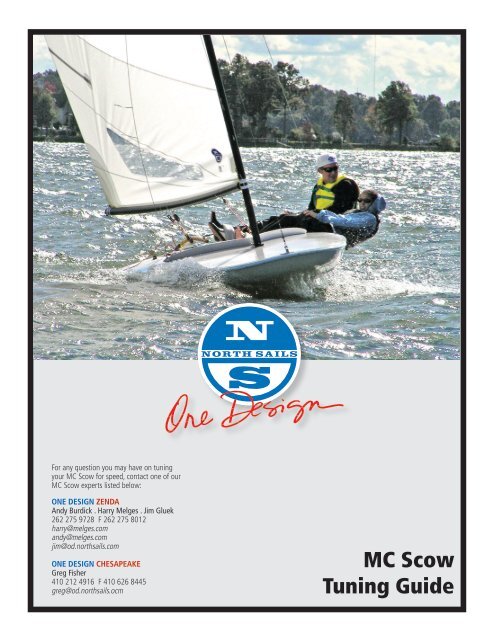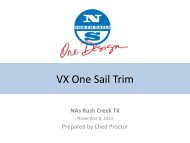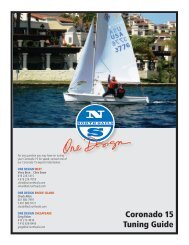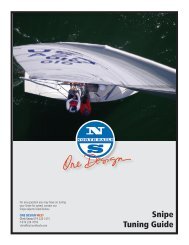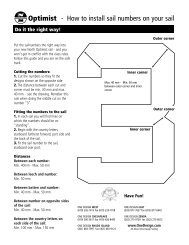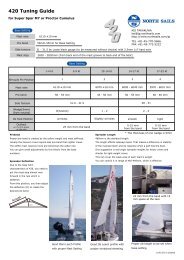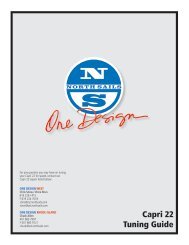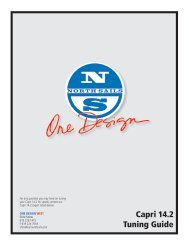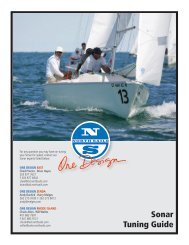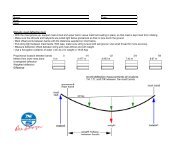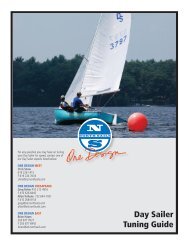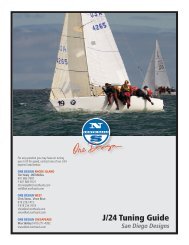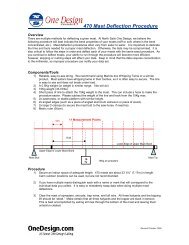MC Scow Tuning Guide - North Sails - One Design
MC Scow Tuning Guide - North Sails - One Design
MC Scow Tuning Guide - North Sails - One Design
You also want an ePaper? Increase the reach of your titles
YUMPU automatically turns print PDFs into web optimized ePapers that Google loves.
For any question you may have on tuning<br />
your <strong>MC</strong> <strong>Scow</strong> for speed, contact one of our<br />
<strong>MC</strong> <strong>Scow</strong> experts listed below:<br />
ONE DESIGN ZENDA<br />
Andy Burdick . Harry Melges . Jim Gluek<br />
262 275 9728 F 262 275 8012<br />
harry@melges.com<br />
andy@melges.com<br />
jim@od.northsails.com<br />
ONE DESIGN CHESAPEAKE<br />
Greg Fisher<br />
410 212 4916 F 410 626 8445<br />
greg@od.northsails.ocm<br />
<strong>MC</strong> <strong>Scow</strong><br />
<strong>Tuning</strong> <strong>Guide</strong>
NORTH SAILS<br />
Thank you very much for your purchase of<br />
a new <strong>MC</strong> <strong>Scow</strong> Mainsail from <strong>North</strong> <strong>Sails</strong>.<br />
The new Z Max has proven to be a<br />
fantastic all around sail for all sailors.<br />
Simple to set up, easy to use and trim.<br />
This new sail has won every major regatta<br />
on the very competitive <strong>MC</strong> regatta circuit.<br />
Now we have a new sail the ZAP. Another<br />
breakthrough sail from <strong>North</strong> that utilizes<br />
our fast AP design with the panel and<br />
cloth selections used in our very successful<br />
Z Max. Also, our hard cloth Masters and<br />
AP mainsails are still the sail of choice for<br />
many <strong>MC</strong> sailors. You can be confident<br />
that this tuning guide will specifically help<br />
you with your <strong>MC</strong> performance.<br />
REvIEw yOuR EQuIPmENt<br />
Take the time to check all of your pins<br />
and stays for wear. Clean your mast and<br />
spreaders with soap and water or Acetone.<br />
Also, please check your halyard. Clean<br />
and lubricate your turnbuckles. Tape your<br />
turnbuckles so that they stay in the set<br />
position.<br />
SEttING uP yOuR mASt<br />
Please install your sidestay turnbuckles<br />
in the forward hole of your chainplates.<br />
Tighten the bolts with a 7/16” wrench.<br />
Have the bottom of the spar held down<br />
on the mast step plate while you walk the<br />
spar up. Hook up the forestay in the aft<br />
cut out of the bow plate.<br />
Once your mast is stepped into position<br />
take a 50ft. steel tape measure and attach<br />
it to the shackle on the wire main halyard.<br />
Pull your rope halyard so that the tape<br />
goes all the way to the top of the spar.<br />
Be sure you latch the ball into the<br />
halyard latch at the top of the spar.<br />
Pull down on your halyard so that<br />
you know it is in place.<br />
Measure down to the center portion of the<br />
deck at the stern. This measurement must<br />
be taken from the point where the hull<br />
and deck meet. The fast measurement for<br />
your Z MAX and or ZAP Mainsail is 28’ 3”.<br />
Now you are ready to set your sidestays.<br />
SIDEStAy ADjuStmENt<br />
After you have set your mast rake at<br />
28’ 3” you will be ready to adjust your<br />
sidestay tension. You want your sidestays<br />
to be taught. You want to just finger<br />
tighten your stays. If you use a wrench to<br />
further tighten them the rig is too tight.<br />
Racing with your new<br />
ZmAx or ZAP mainsail<br />
upwind Racing<br />
Your new Z MAX and or ZAP Mainsail<br />
is going to excel upwind. By following<br />
the guidelines noted below you will<br />
optimize your chances for a distinct speed<br />
advantage over your competition. The Z<br />
MAX and or ZAP are two sails in one. You<br />
can make the sail full and powerful or you<br />
can flatten the sail so that your <strong>MC</strong> is easy<br />
to handle in the breeze. Please practice<br />
the following techniques and watch your<br />
<strong>MC</strong> sailing improve!<br />
<strong>One</strong> thing to mention is that the helmsman<br />
will want to always sit forward in the boat<br />
(right next to your mainsheet cleat) in all<br />
conditions, upwind or downwind. This is<br />
very important.<br />
The order in which to adjust your sail<br />
controls will be in the order described<br />
below. Please follow this sequence in<br />
order to achieve the ultimate speed with<br />
your Z MAX or ZAP.<br />
Visit our web site at www.<strong>One</strong><strong>Design</strong>.com for the latest <strong>MC</strong> <strong>Scow</strong> news and tuning tips.<br />
© 2008 <strong>North</strong> <strong>Sails</strong> <strong>One</strong> <strong>Design</strong>. All rights reserved.<br />
<strong>MC</strong> <strong>Scow</strong><br />
<strong>Tuning</strong> <strong>Guide</strong><br />
POwER uP (0-8 m.p.h.)<br />
The Z design mainsails will be the fullest<br />
sail on the racecourse. So, going for<br />
extreme power will be easy. Please follow<br />
the set up described below.<br />
BOARDS<br />
Be sure that your leeward board is all the<br />
way down so that the head of the board is<br />
flush with the deck.<br />
HEEL<br />
Never allow water to run over the edge of<br />
the leeward side rail. You are overheeled<br />
then. You do want to heel the boat to<br />
reduce wetted surface area. Use the<br />
leeward rail as your guideline in all wind<br />
conditions.<br />
tECHNIQuE<br />
In the light air most <strong>MC</strong> racers choose to<br />
trim and head up the moment they get<br />
new pressure. The exact opposite is the<br />
case if you want to go fast. When you<br />
get hit with a puff you want to ease a bit,<br />
head down and go for speed and then<br />
trim. After this you can head up a bit and<br />
point the boat. The #1 goal is to achieve<br />
boat speed in this light air condition. The<br />
Z design mainsails will really respond to<br />
this type of technique.<br />
mAINSHEEt tRIm<br />
The mainsheet is your accelerator. Never<br />
cleat your mainsail. Always have the<br />
mainsheet in your hand so that you can<br />
trim in the pressure and ease in the light<br />
spots.<br />
In the very light air a great reference for<br />
mainsheet trim is to have the back of the<br />
boom over the back leeward corner of the<br />
boat. As you get more wind trim from<br />
there and feel the sail and boat respond.<br />
If the boat does not respond then ease<br />
your sail back out.<br />
1
NORTH SAILS<br />
OutHAuL<br />
Your outhaul should be tight along the<br />
boom. Yes, you should have a shelf in the<br />
sail even in these light conditions. Pull the<br />
sail to the inboard edge of the white band<br />
on your boom end. This creates a small<br />
wrinkle free shelf foot and is very fast.<br />
This will help you with speed and pointing.<br />
vANG<br />
Do not have any vang tension on at all. In<br />
fact, be sure your vang is uncleated so that<br />
when you ease your mainsail your vang<br />
does not tension up. This is very important<br />
while working your mainsail upwind.<br />
Vang should never be applied in such light<br />
conditions.<br />
CuNNINGHAm<br />
Be sure this sail control is off so that there<br />
are horizontal wrinkles in the luff of the<br />
sail. You want these wrinkles in this type<br />
of wind condition.<br />
tRAvELER<br />
Keep your traveler on centerline at all<br />
times. The only time you drop the traveler<br />
down is when you are fully hiked out and<br />
you cannot hold the boat down.<br />
Downwind Racing<br />
The Z design mainsails will out perform<br />
other shapes due to its fullness downwind.<br />
The sail is full away from the mast (more<br />
draft aft) so this translates into exceptional<br />
speed downwind. This is by far our fastest<br />
sail ever downwind. Practice the following<br />
tips so that you can achieve ultimate<br />
speed.<br />
Once you have rounded your weather<br />
mark be sure to pull your leeward board<br />
up 75% of the way up. Begin to look for<br />
wind behind you. Speed is king downwind<br />
and the only way to have speed is to be<br />
in the breeze. Set yourself up so that you<br />
have clear air and that you are in line for<br />
more breeze moving down the lake. This is<br />
very important.<br />
tECHNIQuE<br />
You must heel your boat to leeward in<br />
order to reduce the wetted surface area<br />
in these conditions. The end of the boom<br />
should be kissing the water. If this is not<br />
happening you are not maximizing your<br />
speed.<br />
Your mainsheet trim is critical as well. Just<br />
like upwind, you absolutely must work<br />
your mainsheet downwind. Grab your<br />
mainsheet directly from the aft block on<br />
the boom. This eliminates the ratchet and<br />
it gives you quick and direct pull.<br />
In the very light air you must reach the<br />
boat more so that the boat picks up speed.<br />
Heel and head up to generate speed while<br />
trimming in your main. As the boat builds<br />
speed begin to head down, continue to<br />
heel the boat and begin to ease your main<br />
back out. The second the boat feels like it<br />
is going to slow down repeat the process.<br />
In order to go fast downwind in the <strong>MC</strong><br />
you must work just as hard downwind as<br />
you do upwind. Stay prepared to keep the<br />
boat moving and always be looking for<br />
fresh wind.<br />
Traveler is centered, vang off, Cunningham<br />
off for maximum power.<br />
Outhaul must be eased so that the shelf<br />
is gone. Do not ease to the point that the<br />
foot of the sail has vertical wrinkles.<br />
Powerboat waves: Always trim in and<br />
build up speed so that you can blast<br />
through waves. If they are very large you<br />
can pull on some boom vang so that the<br />
Visit our web site at www.<strong>One</strong><strong>Design</strong>.com for the latest <strong>MC</strong> <strong>Scow</strong> news and tuning tips.<br />
© 2008 <strong>North</strong> <strong>Sails</strong> <strong>One</strong> <strong>Design</strong>. All rights reserved.<br />
<strong>MC</strong> <strong>Scow</strong><br />
<strong>Tuning</strong> <strong>Guide</strong><br />
rig stays snug and so that the boom stays<br />
in place. Be sure to uncleat the vang after<br />
the waves have passed.<br />
uLtImAtE SPEED (8-15 m.p.h.)<br />
upwind Racing<br />
The Z design mainsails are very versatile<br />
in these conditions. As you know once<br />
you get over 10 m.p.h. the <strong>MC</strong> can be<br />
overpowering (difficult to hold down<br />
upwind) for some sailors. By following the<br />
set up described below you will begin to<br />
see major speed improvements in your <strong>MC</strong><br />
sailing. Practice these things so that you<br />
are smooth and prepared for the change<br />
in velocity.<br />
BOARDS<br />
Please be sure that the head of your<br />
boards are flush with your deck or 1”<br />
up as the wind increases. Putting them<br />
higher is not needed.<br />
HEEL<br />
Again, the benchmark is your leeward rail.<br />
Never allow this to get wet while sailing<br />
upwind. As the wind begins to build, you<br />
must hike harder, use your sail controls to<br />
flatten the main and then feather the boat<br />
lightly into the wind with your steering<br />
technique.<br />
tECHNIQuE<br />
For maximum speed you need to really<br />
work the boat. Hike in the puffs in order<br />
to hold the boat down. However, always<br />
keep your back vertical to the water or<br />
just aft of vertical so that you can see<br />
your horizon line. The horizon tells you<br />
just how much heel is indeed on your<br />
<strong>MC</strong>. Also, by being vertical you can trim<br />
and ease your mainsheet helping you to<br />
balance your boat.<br />
2
NORTH SAILS<br />
mAINSHEEt tRIm<br />
You can trim harder in these conditions<br />
so long as you can hold your boat down.<br />
Once you become overpowered in this<br />
wind range you must begin to ease your<br />
mainsheet in the puffs. You never want<br />
the boat to overheel. When the boat does<br />
heel up you must have boom vang on so<br />
that the sail remains flat as you ease the<br />
sail. In this condition you should sail off<br />
the angle of heel. Meaning, if you have<br />
to ease your mainsheet a foot in order<br />
to help hold the boat down then do this.<br />
The worst thing you can do is trim hard,<br />
overheel and then stuff the boat into<br />
the wind. By easing the mainsail you are<br />
able to sail at a ‘fast angle’ –not stuffed<br />
into the breeze. The boat will accelerate<br />
and begin to build speed. Never cleat<br />
your mainsail. Constant angle of heel<br />
translates into constant fast speed.<br />
OutHAuL<br />
The foot of your sail should have a shelf<br />
in it. Even in the lighter air. So, in this<br />
medium condition you should pull your<br />
outhaul maximum outboard. This helps<br />
to flatten the bottom portion of the main,<br />
which is quite full. Make sure you pull on<br />
this hard taking the sail to the inboard<br />
edge of the black band on your boom<br />
end. Do this before your leeward buoy<br />
roundings too.<br />
vANG<br />
Due to different weight ranges we will<br />
all become overpowered at different<br />
times. Overpowered again meaning that<br />
it is difficult to hold the boat down. So,<br />
someone weighing 150 pounds will<br />
become overpowered in 10 m.p.h. of wind<br />
where someone weighing 200 pounds will<br />
become overpowered in 15 m.p.h. of wind.<br />
As soon as you become overpowered you<br />
need to apply your vang so that the mast<br />
will bend and the sail will flatten. Also,<br />
now you can ease your mainsheet so that<br />
you can keep the boat from overhealing in<br />
the puffs. The more wind the more vang<br />
you will need to apply going upwind.<br />
CuNNINGHAm<br />
With the new Z design mainsails you<br />
can apply much more Cunningham in<br />
order to flatten the sail. By applying the<br />
Cunningham you will move the draft of the<br />
sail forward and the sail will become much<br />
flatter along the mast. This too will bend<br />
the mast when pulled on hard – helping<br />
you to point. When it becomes very windy<br />
you must crank this on hard.<br />
tRAvELER<br />
As the wind builds you can drop your<br />
mainsheet traveler as much as 6” with<br />
the new Z design mainsails. Mark<br />
your traveler track so that you know<br />
the distance. Once you have dropped<br />
the traveler, pulled on your vang and<br />
Cunningham then you need to work your<br />
mainsheet in the puffs, easing when the<br />
boat wants to heal too much.<br />
Downwind Racing<br />
With the breeze up now it is time to sit<br />
on the high side going downwind. This<br />
is also called reverse heeling the boat.<br />
You do this to eliminate helm on the<br />
rudder. When sailing downwind in these<br />
conditions you want the weather board to<br />
be down ¼ of the way. The leeward board<br />
is all the way up.<br />
Upon rounding your weather mark or<br />
offset you will want to adjust the board<br />
first and then ease your outhaul so that<br />
the shelf in the foot is gone. When sailing<br />
straight downwind be sure to ease your<br />
mainsail so that it is all the way out. Your<br />
boom will actually rub against the sidestay.<br />
Visit our web site at www.<strong>One</strong><strong>Design</strong>.com for the latest <strong>MC</strong> <strong>Scow</strong> news and tuning tips.<br />
© 2008 <strong>North</strong> <strong>Sails</strong> <strong>One</strong> <strong>Design</strong>. All rights reserved.<br />
<strong>MC</strong> <strong>Scow</strong><br />
<strong>Tuning</strong> <strong>Guide</strong><br />
As the wind builds apply more and more<br />
vang. Downwind this becomes the<br />
stabilizer for the boat. When the boat<br />
feels very jumpy or tippy apply more<br />
vang in order to stabilize your boat.<br />
Vang is crucial to downwind speed and<br />
acceleration. Please work your vang in the<br />
puffs. Applying more as the wind hits and<br />
the boat speeds up. In the lulls, ease the<br />
vang. Working the boat like this is very<br />
fast.<br />
Always keep your weight forward and<br />
outboard. Lean out as much as possible<br />
so that the boat rocks up downwind. This<br />
helps to reduce the wetted surface area<br />
and it prevents you from ever nose-diving<br />
in large waves or chop. Even lean out<br />
when adjusting your boards after a gybe.<br />
The board lines are tied together so that<br />
you can sit on the high side, lean out and<br />
pull the leeward board up. Doing these<br />
types of things make a big difference over<br />
a long race.<br />
Most important, always look behind you<br />
for the next available wind. Staying in the<br />
wind makes all the difference. With the<br />
new Z design mainsails you will go fast<br />
downwind for sure. However, being in the<br />
breeze will help even more. Be aware of<br />
the new wind coming down the lake.<br />
PERfORmANCE AND CONtROL<br />
(15-25 m.p.h.)<br />
upwind Racing<br />
The Z Max and ZAP mainsails are truly<br />
the best all around sail because it can be<br />
flattened in these conditions. You can<br />
bend your mast and flatten your sail for<br />
great upwind speed and control. With<br />
the custom material we have chosen for<br />
3
NORTH SAILS<br />
the body of this sail you really can have<br />
2 sails in one. You can flatten this sail to<br />
be just like a heavy air sail. Follow along<br />
and see what you can do to reach better<br />
performance and have more control in<br />
this type of wind condition. <strong>One</strong> of the<br />
very best things that you can do of course<br />
is go out and practice in this wind range<br />
so that you feel comfortable in the boat.<br />
Your boat handling will improve for all<br />
conditions as well.<br />
BOARDS<br />
Raising the board in this breeze can be<br />
advantageous. Especially if you are sailing<br />
alone. Please try moving the head of the<br />
board 2” above the board box. We feel<br />
that you will experience less helm and<br />
more maneuverability.<br />
HEEL<br />
Over-heeling is the biggest mistake made<br />
when it is very windy. When you have<br />
all your sail controls on hard you must<br />
“feather” the boat into the wind. Do not<br />
stuff the boat – you must keep the boat<br />
moving fast through the water. Easing<br />
your mainsheet as much as 2 feet may be<br />
needed in order to keep your boat on the<br />
proper angle of heel. Do not be afraid to<br />
ease the sail this much when it is windy.<br />
tECHNIQuE<br />
The mainsheet is your accelerator in light<br />
air and the controller of your angle of<br />
heel in the heavy air. Practice not cleating<br />
your mainsheet. Have the mainsheet in<br />
your hand and be able to ease the sail<br />
in the puffs and trim back in as the puff<br />
leaves. This will de-power your boat. The<br />
Z designed mainsails are a flat sail when<br />
all of your sail controls are pulled on so<br />
now it is up to your mainsheet tension<br />
and steering to keep the boat on its lines.<br />
Hiking out is important as well. If you<br />
have a crew in these conditions make sure<br />
to call out the puffs early so that the crew<br />
is fully hiked before the breeze is on.<br />
mAINSHEEt tRIm<br />
There is no set trim guideline in this much<br />
breeze. You do not need to trim hard that<br />
is for sure. With a lot of vang on you can<br />
ease the sail as much as 2 feet and not<br />
loose any speed at all. The mainsheet just<br />
controls your heel in this much wind. So,<br />
if you are over-heeled then ease until the<br />
boat settles down. While easing keep the<br />
boat on its lines – a normal course. Do<br />
not stuff the boat into the wind because<br />
then you will stop. Sail the boat fast by<br />
easing the main. Always feather the boat<br />
into the wind.<br />
OutHAuL<br />
Pull hard out to the black band on the<br />
boom. Never ease in from this point with<br />
this much velocity.<br />
vANG<br />
When you are trimmed in going upwind<br />
you need to pull the vang hard. This<br />
will bend the mast, flatten your Z design<br />
mainsail and then open the leech. The<br />
boat will become very controllable. You<br />
may need to ease this a bit on the tacks<br />
and always be sure to ease the vang at<br />
least an arms length before rounding the<br />
weather mark. Otherwise you could bend<br />
your mast.<br />
Vang tension is very critical in this much<br />
wind. Apply plenty when racing upwind.<br />
At the start it does hurt your pointing<br />
ability so, you may want it eased a bit, but<br />
not completely eased off.<br />
CuNNINGHAm<br />
Pull this as hard as you can. The sail will<br />
flatten right out, especially along the front<br />
of the spar. You could never pull too hard<br />
on this control in this much wind.<br />
Visit our web site at www.<strong>One</strong><strong>Design</strong>.com for the latest <strong>MC</strong> <strong>Scow</strong> news and tuning tips.<br />
© 2008 <strong>North</strong> <strong>Sails</strong> <strong>One</strong> <strong>Design</strong>. All rights reserved.<br />
<strong>MC</strong> <strong>Scow</strong><br />
<strong>Tuning</strong> <strong>Guide</strong><br />
tRAvELER<br />
You can drop this up to 9” if it is this<br />
windy and you do not have the weight<br />
on the boat to hold it down. If you have<br />
a crew I still would not drop the traveler<br />
more than 6”. When sailing alone you<br />
could go 3” further. Set this control, leave<br />
it, and then work your mainsheet.<br />
Downwind Racing<br />
Certainly, in this much wind you must<br />
reverse heel the boat. Your board should<br />
be dropped just ¼ of the way down. Do<br />
not sail downwind with both boards down.<br />
It is slow and it could cause you to tip over<br />
upon maneuvering.<br />
Apply vang downwind so that the boat is<br />
more stable. However, be sure to not oversteer<br />
on your gybes. The boom could catch<br />
the water and take you for a swim. To be<br />
safe, ease the vang a bit before a gybe in<br />
big air. Leaving the outhaul on when it is<br />
windy will not hurt your downwind speed.<br />
So, do not worry about this control. Worry<br />
about being in the wind, sailing safe and<br />
going fast.<br />
When you are sailing in waves keep your<br />
weight in your normal position. To avoid<br />
nose-diving just lean out so the boat is<br />
heeled. This will help to prevent nosediving.<br />
If you see a big set of waves do<br />
not be afraid to trim in and head up 10-15<br />
degrees to reach around them. Trim your<br />
sail, accelerate and then head down with<br />
your extra speed after the set of waves.<br />
Please enjoy your new <strong>North</strong> Z <strong>Design</strong><br />
Mainsail. It is the fastest sail in all<br />
conditions you can be assured of this. If<br />
you have questions please call or email us<br />
here at <strong>North</strong> <strong>Sails</strong> Zenda.<br />
4
NORTH SAILS<br />
NORtH SAILS ONE DESIGN<br />
QuALIty CONtROL CHECK<br />
Corners<br />
Cunningham<br />
Numbers<br />
Battens<br />
Leech Telltales<br />
Insignia<br />
Serial Number<br />
Royalty<br />
<strong>North</strong> Logo<br />
Bag<br />
mAINSAIL<br />
Checked by: _____________________<br />
Date: ____ / ____ / ____<br />
Visit our web site at www.<strong>One</strong><strong>Design</strong>.com for the latest <strong>MC</strong> <strong>Scow</strong> news and tuning tips.<br />
© 2008 <strong>North</strong> <strong>Sails</strong> <strong>One</strong> <strong>Design</strong>. All rights reserved.<br />
<strong>MC</strong> <strong>Scow</strong><br />
<strong>Tuning</strong> <strong>Guide</strong><br />
5


